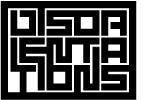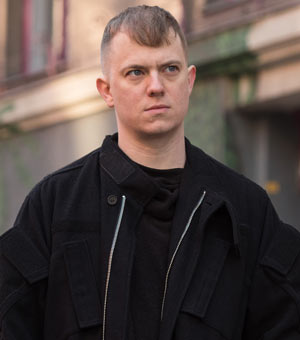Becoming Sobject: Considerations of Vehicularity and ‘Wild Writing’
by Travis Jeppesen on July 24, 2014
At the root of it, we have the struggle of imposition – that rapedance that language does which is a gesturing towards containment, a process that can never be completed. Nietzsche complained of it in On the Genealogy of Morals: that version of morality wherein the aristocracy coins a word for a thing, and in so doing, effectively gains possession of it. Of course, in doing so, the aristocracy is also lying to itself, because in point of fact meaning-formation takes place on quite other terrain – it is more subterranean and hence geological than anything that might be inferred by a mere word. The sign winds up being, despite our best efforts, wrong; but the meaning is wrong as well – at best speculative; the only thing we may cling to is the fact that certainty is an illusion. Rather than considering this a depressive force, we should see it as the life force that it is; indeed, a total divorce from meaning – were such a thing possible – might be the closest we get to the experience of ‘freedom’, as it is often posited.
Visual artists working outside the domain of spoken and written language have known this for some time, and now that writing is beginning to enter into the domain of art, the ‘art world’ as it is now known, then it stands to take the trouble – for it is a troubling thought – to articulate the stance once again. There are four things: there is image there is word there is sound there is gesture. We favor the last, gesture, because it is so fleeting. If there is a semiotic equivalent, then it is the scrawl – the mark of gesturality that posits itself somewhere between word and image, yet is markedly asignifying. It is that thing that can be inferred, but hardly captured.
We could conjure a ‘wild writing’, a writing to come, that positions itself within a cognizance of language’s ultimate failure, its impossibility to truly mean, and that frees language from its increasingly endangered position as a vehicle for conveying forms of meaning acceptable to the masses in the so-called information age, and rather utilises language as a medium for creating new sounds, new meanings. Language against the law, against information. Wild writing would then be part of a tradition that includes the Russian Futurists, the American L=A=N=G=U=A=G=E poets, asemic writing… The Stein of Tender Buttons, the Joyce of Finnegans Wake, the Guyotat of Eden Eden Eden.
Who would create this. That is a question. We might conceive of a new means of picturing the creating being. The being-as-object. The sobject. The machine… A model that reverts to a physicalist standpoint, refuting the body–mind division of the Cartesian. For mind is but an extension of body, and vice versa. A wild writing would first of all be a writing of the body. One in which body takes precedence over mind, and thus: the body–mind vehicle. But what does it mean to become a body–mind vehicle? It means, first of all, that you program yourself. When we speak of programming the self, then we leave behind the norms of human psychology and begin speaking the language of the mechanic, the language of the machine. But a vehicle is a very particular sort of machine, a machine that is defined by movement, by constant motion. That is what it is designed for; not staticity, not the contained motion of, say, the blender. So: a vehicle is a machine, but a specific kind of machine. Program yourself before someone else does it for you. This should be the ultimate pedagogical aim.
As human beings, we have a quality that distinguishes us from other objects. It is our remarkable ability, not just to create things outside of ourselves but to self-program. Self-programming, one becomes an object with agency, a sobject. Sobjectivity is rooted in the awareness that creation is not merely a mental process, but a physical, bodily one, as well. No Cartesian splits are acknowledged by the sobjectivist, the automaticist – by the wild writer. Instead, the principle of extension rules, wherein mind is but an extension of body, and vice versa. The sobjectivist is constantly trying to evade the frame, to go outside the territorial entrapments of the socius. Sobjectivity concerns itself with the mechanics of the body–mind machine, rather than the results; hence the machine’s vehicularity. That is to say, the purpose is the process, the movement, the action – not what it completes. Never the final product. Which is not to say that the final product has no value. But due to the way the rest of the socius has been programmed, and the fact that the automaticist’s gesture is a contra-programming, the socius’s natural reaction to the final product is one of revulsion and rejection; hence, bad art, a ‘wild writing’, is produced as a critical reaction to the conditions of meaning-formation outlined above.
For a ‘wild writing’, a boundary-less etching into the future unknown, a writing that is inherently frameless, it becomes all about extension – the self no longer a self but a vehicle, the writing a trajectory extending always outwards in countless directions – projective pathways melded to the earth. The earth is alive and all life ultimately sprang from the inanimate. If we are to accept this as a fact of evolution, then it follows that we can’t really tell what is alive anymore and what’s not. Wild writing would be a part of the hylozoic revivalism that is happening in other fields, such as philosophy (object-oriented ontology) and ecology. No longer any differentiating boundaries erected between the self and the art object, the ground and the sky, the creator and the created. Consider the object as a thing, no different than you, the sobject. Your goal is to infest it with agency, even if it does not resemble verbatim the agency through which you perceive and mold perception. In going, the sobject, self-object, I-object, gives off pollution, which then becomes the art object. It is not the final destination, but a result of the ceaseless movement.
Identity politics was perhaps the last major mainstream attempt to cling to established categoricals as a means of affirming the significance of the subject. With a reconsideration of the universe from the standpoint of the being-object, we begin to see the fruitlessness of identity politics’ quest of instance-finding, yet can still find and fight against the systematic forms of discrimination that human objects must combat in their daily peregrinations. Wild writing is programatically against this, all systems. This is what it means to operate framelessly. A robotics of the self need not exclude the political, social dimension, but the tactical considerations will be different for each sobject. There is no army here. Nor can we declare that the sobject has no thoughts, no emotions. But why anyway give thoughts and emotions primacy over the physical and spectral qualities of a sobject?
Becoming sobject is a way out: a method of leaving behind the old trappings of the self. Sobjectity goes beyond mere thingness in its necessitude to claim a spectral identity, as well as a concrete body-form. It considers that the object, beyond being mere thing, is vision, a perceptive device – a surface filled with ego eyes. The writing that shoots out of us thus forms a scape that runs parallel to the terrain we occupy. A being without the frame, without the law. A ground where wild gesture, constant movement is able to thrive – as this new ground is made out of gesture itself.
Commissioned by curator Anders Kreuger for Don’t You Know Who I Am?: Art After Identity Politics, an e-book to accompany the exhibition of the same name, on until 14 September 2014 at the Museum of Contemporary Art in Antwerp. The complete e-book can be downloaded here.


2 comments
Hey Travis —
I actually wanted to reach out to you as I have somehow ended up writing a paper about you for a class last semester at the new school — entitled art in the xxi century — sort of about the inclusion of so many literarily inclined artists at the 2014 biennial, but ended up reading suiciders and victims which both peaked my interest
was wondering if i could pick your brain about the whole disorientation process.
i have tried to steal your technique by timing myself to write for five minutes, no matter what gibberish it happens to be, each day – but wondered if you could possibly speak further on how that relates to the way you write about art?
would be glad to send you my paper. was from may, but i had titled it ‘attempts to understand new ways of writing about art’, i got an a-, i’ll take it!
by Maggie on July 26, 2014 at 2:29 am. #
Dude, right on there brrheto.
by Sergio on October 19, 2015 at 8:41 am. #